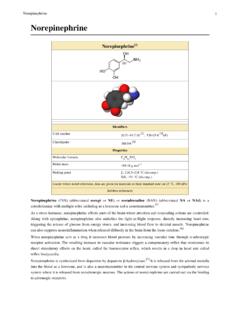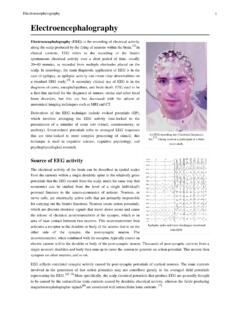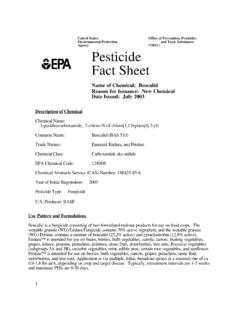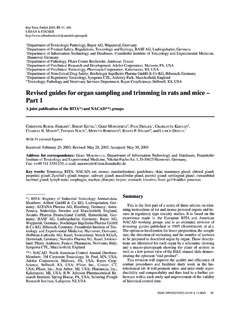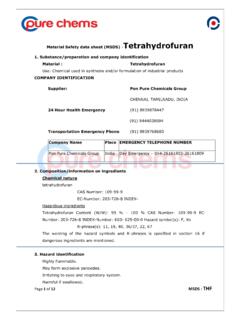Transcription of Hippocampus - Rice University
1 Hippocampus1 Hippocampus Brain: Hippocampus The Hippocampus is located in the medial temporal lobe of the brain. In this lateral view of the human brain, the frontal lobe is at left,the occipital lobe at right, and the temporal and parietal lobes have largely been removed to reveal the Hippocampus [1]MeSHHippocampus [2]NeuroLex IDbirnlex_721 [3]The Hippocampus is a major component of the brains of humans and other mammals. It belongs to the limbicsystem and plays important roles in long-term memory and spatial navigation. Like the cerebral cortex, with which itis closely associated, it is a paired structure, with mirror-image halves in the left and right sides of the brain. Inhumans and other primates, the Hippocampus is located inside the medial temporal lobe, beneath the cortical Alzheimer's disease the Hippocampus is one of the first regions of the brain to suffer damage; memory problemsand disorientation appear among the first symptoms.
2 Damage to the Hippocampus can also result from oxygenstarvation (hypoxia), encephalitis, or medial temporal lobe epilepsy. People with extensive hippocampal damagemay experience amnesia the inability to form or retain new rodents, the Hippocampus has been studied extensively as part of the brain system responsible for spatial memoryand navigation. Many neurons in the rat and mouse Hippocampus respond as place cells: that is, they fire bursts ofaction potentials when the animal passes through a specific part of its environment. Hippocampal place cells interactextensively with head direction cells, whose activity acts as an inertial compass, and with grid cells in theneighboring entorhinal different neuronal cell types are neatly organized into layers in the Hippocampus , it has frequently been used asa model system for studying neurophysiology.
3 The form of neural plasticity known as long-term potentiation (LTP)was first discovered to occur in the Hippocampus and has often been studied in this structure. LTP is widely believedto be one of the main neural mechanisms by which memory is stored in the earliest description of the ridge running along the floor of thetemporal horn of the lateral ventricle comes from the Venetiananatomist Julius Caesar Aranzi (1587), who initially likened it to asilkworm, and then a seahorse (Latin: Hippocampus , from Greek: , "horse" and Greek: , "sea monster"). The Germananatomist Duvernoy (1729), the first to illustrate the structure, alsowavered between "seahorse" and "silkworm." "Ram's horn" wasHippocampus2proposed by the Danish anatomist Jacob Winsl w in 1732; and a decade later his fellow Parisian, the surgeon deGarengeot, used "cornu Ammonis" - horn of (the ancient Egyptian god) Amun.
4 Today, the structure is called thehippocampus.[4] De Garengeot's "cornu Ammonis" survives in the names of the three main histological divisions ofthe Hippocampus : CA1, CA2 and CA3. At right is the Hungarian neuroscientist L szl Seress' 1980 preparation ofthe human Hippocampus and fornix compared with a , the earliest widely held hypothesis was that the Hippocampus is involved in olfaction. This idea waslargely motivated by a belief, later shown to be false, that the Hippocampus receives direct input from the olfactorybulb.[5] There continues to be some interest in hippocampal olfactory responses, particularly the role of thehippocampus in memory for odors, but few people believe today that olfaction is its primary function.[6] [7]Over the years, three main ideas of hippocampal function have dominated the literature: inhibition, memory, andspace.
5 The behavioral inhibition theory (caricatured by O'Keefe and Nadel as "slam on the brakes!")[8] was verypopular up to the 1960s. It derived much of its justification from two observations: first, that animals withhippocampal damage tend to be hyperactive; second, that animals with hippocampal damage often have difficultylearning to inhibit responses that they have previously been taught. Jeffrey Gray developed this line of thought into afull-fledged theory of the role of the Hippocampus in anxiety.[9] The inhibition theory is currently the least popular ofthe three.[10]The second major line of thought relates the Hippocampus to memory. Although it had historical precursors, this ideaderived its main impetus from a famous report by Scoville and Brenda Milner[11] describing the results of surgicaldestruction of the Hippocampus (in an attempt to relieve epileptic seizures), in a patient named Henry GustavMolaison,[12] known until his death in 2008 as The unexpected outcome of the surgery was severe anterogradeand partial retrograde amnesia: was unable to form new episodic memories after his surgery and could notremember any events that occurred just before his surgery, but retained memories for things that happened yearsearlier, such as his childhood.
6 This case produced such enormous interest that reportedly became the mostintensively studied medical subject in history.[13] In the ensuing years, other patients with similar levels ofhippocampal damage and amnesia (caused by accident or disease) have been studied as well, and thousands ofexperiments have studied the physiology of activity-driven changes in synaptic connections in the is now almost universal agreement that the Hippocampus plays some sort of important role in memory;however, the precise nature of this role remains widely debated.[14] [15]The third important theory of hippocampal function relates the Hippocampus to space. The spatial theory wasoriginally championed by O'Keefe and Nadel, who were influenced by Tolman's theories about "cognitivemaps" in humans and animals.
7 O'Keefe and his student Dostrovsky in 1971 discovered neurons in the rathippocampus that appeared to them to show activity related to the rat's location within its environment.[16] Despiteskepticism from other investigators, O'Keefe and his co-workers, especially Lynn Nadel, continued to investigatethis question, in a line of work that eventually led to their very influential 1978 book The Hippocampus as aCognitive Map.[17] As with the memory theory, there is now almost universal agreement that spatial coding plays animportant role in hippocampal function, but the details are widely debated.[18]Role in memoryPsychologists and neuroscientists generally agree that the Hippocampus has an important role in the formation ofnew memories about experienced events (episodic or autobiographical memory).
8 [15] [19] Part of this role ishippocampal involvement in the detection of novel events, places and stimuli.[20] Some researchers view thehippocampus as part of a larger medial temporal lobe memory system responsible for general declarative memory(memories that can be explicitly verbalized these would include, for example, memory for facts in addition toepisodic memory).[14]Hippocampus3 Severe damage to the Hippocampus results in profound difficulties in forming new memories (anterograde amnesia),and often also affects memories formed before the damage (retrograde amnesia). Although the retrograde effectnormally extends some years before the brain damage, in some cases older memories remain this sparing of oldermemories leads to the idea that consolidation over time involves the transfer of memories out of the Hippocampus toother parts of the brain.
9 [21]Damage to the Hippocampus does not affect some types of memory, such as the ability to learn new motor orcognitive skills (playing a musical instrument, or solving certain types of puzzles, for example). This fact suggeststhat such abilities depend on different types of memory (procedural memory) and different brain , amnesic patients frequently show "implicit" memory for experiences even in the absence of consciousknowledge. For example, a patient asked to guess which of two faces they have seen most recently may give thecorrect answer the majority of the time, in spite of stating that they have never seen either of the faces before. Someresearchers distinguish between conscious recollection, which depends on the Hippocampus , and familiarity, whichdepends on portions of the medial temporal cortex.
10 [22]Role in spatial memory and navigationSpatial firing patterns of seven place cellsrecorded from a single electrode in the dorsalCA1 layer of a rat. The rat ran several hundredlaps clockwise around an elevated triangulartrack, stopping in the middle of each arm to eat asmall portion of food reward. Black dots indicatepositions of the rat's head; colored dots indicateplaces where action potentials occurred, using adifferent color for each cell.[23]Studies conducted on freely moving rats and mice have shown thatmany hippocampal neurons have "place fields", that is, they fire burstsof action potentials when a rat passes through a particular part of theenvironment. Evidence for place cells in primates is limited, perhaps inpart because it is difficult to record brain activity from freely movingmonkeys. Place-related hippocampal neural activity has been reportedin monkeys moving around inside a room while seated in a restraintchair;[24] on the other hand, Edmund Rolls and his colleagues insteaddescribed hippocampal cells that fire in relation to the place a monkeyis looking at, rather than the place its body is located.

